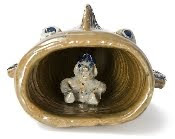I was reminded, when
our architects visited again for Easter, of how unconventional our 'selection process' was. That's their further development of the site plan, including a memorial pavilion to the two young soldiers lost from our congregation, above.
The pavilion is where it all started; when we didn't have the money to build on our 100 acres, the congregation decided to focus on developing the front twenty-five or so intended to be open to the public in a park-like setting, which would include a memorial pavilion to the (then one) young man who had been killed in Iraq, and a lake, and walking trails. I felt near panic at the possibility of a decision to erect a faux-Victorian gazebo from the building store down the street.
Somewhere around page 50 of a desperate google search for 'pavilion' I turned up this:
Never mind that it had been in the courtyard of the British Library, which is one of my favorite places in the great wide world; it had a single post (an idea that had been in my mind as a symbolic sentinel) with support beams which my church-design mind read as a cross, it had been constructed to interact with the sunlight timed to a poetry reading (light is a guiding concept for our church), and it had been constructed by students from stock lumber (woohoo! we could build it ourselves!), so I sent off an email inquiry in hopes that we could just buy the design for some reasonable sum and duplicate it on the lone prairee.
But that is not how proper architects work, and the d's of drdh would no more sell me a pavilion design that was made for another place than they would have sold me a stock church plan made for another church...not out of preciousness but because they knew, as I didn't completely understand at the time, that only a design made for us would really work for us. And when we sat down and had a long talk about the church, and the land, and the light, and Aldo van Eyck, they said they would be happy to make us a pavilion but they really wanted to help us build our building.
If you search out conventional wisdom about how to hire a church architect, one of the most common is 'only use a church specialist, only use a firm that has designed many churches'. This is usually put forward by firms who, guess what, specialize in churches. Whether you choose to go with a 'specialist' or not (and we didn't) doesn't really matter though, if you just remember that in seeking out an architect you're looking for two things, and wherever you find them that will be a good place:
Skill, and Sympathy.
Skill - The firm's work (and yes, you should meet the principals, not some sales department; if you're given any sort of a marketing pitch cross them off your list immediately) should impress you. It doesn't really matter if they're churches or not. For 'skill' do not read 'wow-factor', as in bright colors and swoopy exteriors, and remember that gigantic media screens are not equivalent to good design. Does their portfolio show that they think deeply about what buildings mean to people? About how space works, and how people work within it? About finished details? Have they made spaces that look to you like they would feel good to be in?
Sympathy - Are the principals in sympathy with your goals and desires for the building? If so, they will also be in sympathy with your budget, and respectful of it. Do you feel comfortable with them as people, with how they listen and respond to you? Do they WANT to build your church? Never work with someone that you have to drag into the job.
After a few more visits and talks it was clear that our architects wanted to build our church, and we wanted them to build it. That arrangement, not just of mutual benefit but of mutual desire to accomplish, lends mutual trust. And knowing them to be 'men of skill', as it were
(see Exodus 31:2-5) freed us from the compulsion to prescribe their work, or to submit every detail to a committee review--one of the perennial complaints about the building process within churches. We knew that they could come up with better answers on our behalf than we could on our own. And they have.

















































